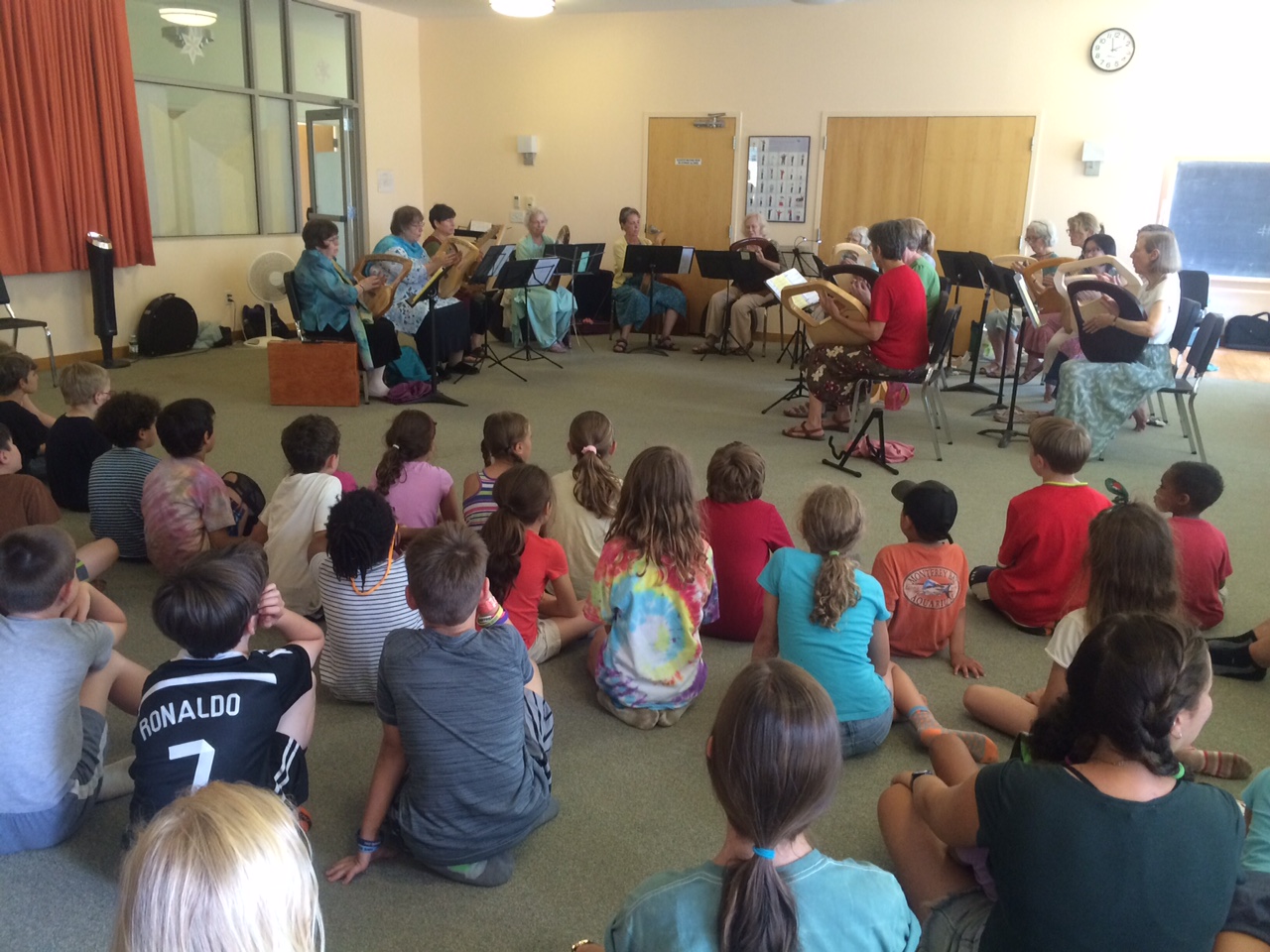By Veronika Roemer
In late July, Channa Seidenberg and I flew to Shenyang, China to teach at a music conference organized by Pan Kai, whom we met at last year’s International Lyre Conference in Detroit. The conference took place at a Waldorf School on the outskirts of Shenyang. The school is set beautifully amid the hills, surrounded by vegetable gardens and forest. A little beyond the school, the first high-rise buildings of the city can be seen, but otherwise one feels like being in the countryside. The school building was well suited for the conference, with large and small classrooms and a large kitchen where our delicious meals were prepared every day. I was placed with 30 children, ages 6 to 12, far enough away from the adults that we could do as we liked.
The program was held over two five-day blocks with one day off in between. This rhythm was a bit of a challenge to get into. We had to keep reminding each other what day of the week it was. I had brought as many of my instruments as possible: gongs, iron and bronze rods, triangle and cymbals, a pentatonic metallophon, small bells, about 12 pairs of wooden sticks, plus my viola. I also collected about 30 pairs of nicely-ringing small stones in the playground of the school. I had been given two translators/classroom helpers, wonderful young adults who were both planning to become Waldorf teachers. Not only did they speak very good English, they were also incredibly helpful with the children, understanding very quickly what I was trying to do and supporting me as best they could.
On Monday morning we started. For the first 30 minutes we sang songs and did rhythm games. Then the children were split into two groups, ages 6 to 8 and 9 to 12. As I worked with one group, the other group went outside for a Kung Fu lesson. During the morning periods we did mostly listening and movement work (like Par Ahlbom teaches, and as it is described beautifully by Reinhild Brass in her book Discovering Ways of Listening, which I am in the process of translating). First we played children’s lyres, and then we did improvisational work with the instruments and lots of rhythmical games.
I had prepared material where language or musical background wouldn’t matter much. Songs and rounds had very few words (hard to find), and a few songs were well suited for dancing. The children learned the songs amazingly fast. They were also very good at rhythm. Rounds and singing in parts were much harder, especially for the younger children, but they enjoyed the challenge and savored it when it finally worked.
Movement didn’t come easily to the children. They tended to walk heavily and drag their feet rather than move with the sound and playing-gesture of a lyre or gong. It was a great joy to me when, during the second five-day block, some of the children suddenly started to move better; more flowingly, gracefully, lighter. Their listening deepened, too, and became more sensitive. It showed in their greater care in playing, particularly the gongs, and in their reactions when a child played too hard.
Every afternoon at 4:00 pm, we met to sing once more for about an hour to conclude the day. In the afternoons I also worked for an hour, alternating between two groups of about 25 special needs children: one, a group of 9- to 12-year-olds; the other, 6- to 8-year-olds. Each group had a number of aids. We did a lot of rhythm games, singing, dancing, and “orchestra” – groups of children had different kinds of instruments like bells, wooden sticks, stones, triangle and cymbals. I would either conduct the groups to play as I moved my hands (strong, soft, fast slow), or I would stand in front of the group that was to play as I improvised on my pentatonic flute.
Looking back, I’m amazed at how much happened during those two five-day blocks. The first day after the break was difficult. The children seemed tired, out of rhythm, needing to reconnect to the music work we had done before. But from the second day on, things began to move. Children started volunteering to play their favorite games and instruments. They came out of themselves a bit more in their individualities. Some of the younger ones started showing me affection. I could feel a difference, too, in the older ones. We were beginning to get to know each other pretty well.
On the last day there was a final presentation. The children sang a few songs. The younger ones showed a lyre game with movement; the older ones, an African song with movement and clapping, and a song by Colin Tanser for two lyres, with the simple lyre part being played by four children with gongs. At the end, all the conference participants sang a prayer for peace in Arabic, Chinese, Hebrew and English in a four-part round. The children started with a short instrumental introduction then sang the first part. Then Channa conducted the adults in singing the remaining three parts. I watched the children as the round grew. Their faces showed surprise, wonder, and awe at the growing sound and harmonic richness of the round. It was a tremendous gift for them to be embedded in such a way in the adult community.
After the music camp ended, I joined the painting course by singing with them for 50 minutes every morning for another five-day block. Channa had been teaching them while I was teaching the children in the music camp. This was the first time I was given so much time for music in a nonmusic course. It was fabulous. We did so much in this time that it allowed the participants to have really deep musical experiences. They sang well; much better than I generally meet among nonmusicians. We started with the tone of the day and went from there into simple guided improvisations. They learned several rounds, a twopart song, and we continued working on “Halleluja”, by Arvo Part, which they had started with Channa. This was difficult for them. Interestingly, they had a hard time with the interval of the second. They would tend to slip either into the third or the prime. But they kept working hard, and on the last day they managed the first three bars of the song in two parts, with perfect seconds.
It was a very rich and inspiring time for me. It was the first time I had a group of children over a period of so many days in such an intensive teaching situation. I treasured having the opportunity to work with them out of Par Ahlbom’s and Reinhild Brass’s impulses, and I hope to have such opportunities here, in the U.S., too. I found the Chinese incredibly warm, friendly, helpful and accommodating – to the point where I would be very careful not to say anything that might sound like a complaint or need, because they would immediately try to remedy the situation for me. A good lesson to learn!

















